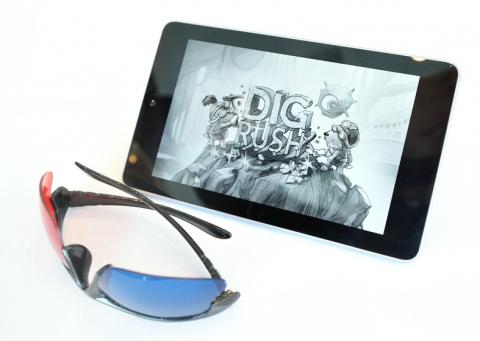Ubisoft SA on Tuesday unveiled a tablet video game crafted as a prescription for a medical condition known as “lazy eye,” blending the worlds of play and healthcare.
The France-based video game titan created Dig Rush in collaboration with US health technology startup Amblyotech Inc, using treatment technology patented by innovators at McGill University in Canada.
“This is a good demonstration of the positive impact that video game technology can have on our society,” Ubisoft senior producer Mathieu Ferland said.

Photo: AFP
The game targets amblyopia, a condition in which a person’s eye and brain are out of sync, and which is reported to affect 3 percent of the global population.
If untreated, people with can go blind in one eye, according to Amblyotech chief executive Joseph Koziak.
“When you look at a person who has it, one eye is visually misaligned as compared to the other,” Koziak said. “The traditional monicker is ‘lazy eye.’”
Amblyopia involves one eye being far less useful than the other, creating a situation in which the brain responds by suppressing visual input from a weak eye and relying on the strong eye, Koziak said.
Relying on one eye results in people losing depth perception.
Dig Rush requires both eyes to take part to effectively play the game. Characters, equipment and scenes set on a gray background are either red or blue, and players wear glasses that filter out one color or the other depending on the eye.
“The only way to play this game is to force the patient to use two eyes,” Ferland said. “This treatment is reconditioning the brain to use both eyes.”
Amblyotech is seeking approval from US regulators to have Dig Rush be prescribed by doctors. Medical care providers would provide tablets as treatment tools, tending to training, calibration and settings, as well as monitoring progress.
Testing has shown Dig Rush is about 90 percent effective in improving the vision of those with the condition, Amblyotech chief operating officer Robert Derricotte said.
Current treatments are relatively ineffective and involve providing a patch to cover a person’s dominant eye to force the weaker eye to work with the brain, but still leave a patient without 3D perception, Derricotte said.
“This is a game-changer,” Derricotte said. “Doctors have been patching patients for over 200 years; this is a radical new way to treat Amblyopia.”
Pricing for the game had yet to be announced.
Koziak saw Dig Rush as the first of a new order of treatments delivered by touch-screen tablets instead of traditional medical methods.
“I look at the tablet as the syringe of the future; where you use a visual display to administer a drug to a patient,” Koziak said. “While this is for an ocular disorder, there are going to be other medical conditions in the future that can be treated through this kind of display.”

LIMITED IMPACT: Investor confidence was likely sustained by its relatively small exposure to the Chinese market, as only less advanced chips are made in Nanjing Taiwan Semiconductor Manufacturing Co (TSMC, 台積電) saw its stock price close steady yesterday in a sign that the loss of the validated end user (VEU) status for its Nanjing, China, fab should have a mild impact on the world’s biggest contract chipmaker financially and technologically. Media reports about the waiver loss sent TSMC down 1.29 percent during the early trading session yesterday, but the stock soon regained strength and ended at NT$1,160, unchanged from Tuesday. Investors’ confidence in TSMC was likely built on its relatively small exposure to the Chinese market, as Chinese customers contributed about 9 percent to TSMC’s revenue last

With this year’s Semicon Taiwan trade show set to kick off on Wednesday, market attention has turned to the mass production of advanced packaging technologies and capacity expansion in Taiwan and the US. With traditional scaling reaching physical limits, heterogeneous integration and packaging technologies have emerged as key solutions. Surging demand for artificial intelligence (AI), high-performance computing (HPC) and high-bandwidth memory (HBM) chips has put technologies such as chip-on-wafer-on-substrate (CoWoS), integrated fan-out (InFO), system on integrated chips (SoIC), 3D IC and fan-out panel-level packaging (FOPLP) at the center of semiconductor innovation, making them a major focus at this year’s trade show, according

DEBUT: The trade show is to feature 17 national pavilions, a new high for the event, including from Canada, Costa Rica, Lithuania, Sweden and Vietnam for the first time The Semicon Taiwan trade show, which opens on Wednesday, is expected to see a new high in the number of exhibitors and visitors from around the world, said its organizer, SEMI, which has described the annual event as the “Olympics of the semiconductor industry.” SEMI, which represents companies in the electronics manufacturing and design supply chain, and touts the annual exhibition as the most influential semiconductor trade show in the world, said more than 1,200 enterprises from 56 countries are to showcase their innovations across more than 4,100 booths, and that the event could attract 100,000 visitors. This year’s event features 17

Hon Hai Precision Industry Co (鴻海精密), which assembles servers for Nvidia Corp, yesterday said that revenue last month rose 10.61 percent year-on-year, driven by strong growth in cloud and networking products amid continued front-loading orders for artificial intelligence (AI) server racks. Consolidated revenue expanded to NT$606.51 billion (US$19.81 billion) last month from NT$548.31 billion a year earlier, marking the highest ever in August, the company said in a statement. On a monthly basis, revenue was down 1.2 percent from NT$613.86 billion. Hon Hai, which is also a major iPhone assembler, added that its electronic components division saw significant revenue growth last month, boosted